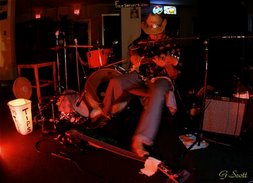Tuesday, August 14, 2012
Coolest thing ever
Curiosity rover: Martian solar day 2 in New Mexico
To get a good view, make it go full screen. The cool thing, besides the view of the martian landscape, is that you can "point" the view downward and see the rover itself. This is just too much.
Sunday, August 05, 2012
Saturday, August 04, 2012
Sleepless night ahead for NASA
http://news.cnet.com/8301-11386_3-57486873-76/curiosity-closes-in-on-mars-for-high-stakes-descent/
Here is an excerpt from the above link:
...Tipping the scales at 1 ton, Curiosity is the largest rover ever sent to Mars and it will hit the upper atmosphere at a blistering 13,200 mph. Protected by a massive insulating heat shield, the spacecraft and its computer will fire rocket thrusters to adjust the craft's lift during the hypersonic phase of the descent, dipping or climbing as required and flying through broad S-turns to bleed off speed while keeping the craft on course for a pinpoint landing.
After slowing to around 1,000 mph, the craft will deploy a huge supersonic parachute, the heat shield will be jettisoned, and a sophisticated radar altimeter will begin sounding the surface. After the craft slows to less than 200 mph, the parachute will be jettisoned and Curiosity, bolted to the belly of a rocket-powered descent stage, will fall free for the final drop to the surface.
Unlike past landers, Curiosity's jet pack doesn't have legs. Instead, it will act like a flying crane, lowering the rover directly to the surface on the end of a 25-foot-long bridle as the "sky crane" slowly descends. When the flight computer senses "weight on wheels," the bridle will be cut and Curiosity will be ready for initial tests and checkout.
Touchdown is expected at 10:17 p.m. PDT Sunday, but it will take radio signals confirming the event 13.8 minutes to cross the 154-million-mile gulf between Earth and Mars. That translates to 10:31 p.m. "Earth-received time."
Engineers at the Jet Propulsion Laboratory in Pasadena, Calif., will be relying on NASA's Mars Odyssey orbiter to relay entry, descent, and landing telemetry back to Earth and to confirm a successful touchdown. If Odyssey has problems, or if any issues crop up with Curiosity's transmitter, it could take several hours for that long-awaited confirmation to arrive.
Given the complexity of the entry, descent, and landing sequence -- and the mission's $2.5 billion price tag -- NASA managers and engineers are understandably anxious...
Here is an excerpt from the above link:
...Tipping the scales at 1 ton, Curiosity is the largest rover ever sent to Mars and it will hit the upper atmosphere at a blistering 13,200 mph. Protected by a massive insulating heat shield, the spacecraft and its computer will fire rocket thrusters to adjust the craft's lift during the hypersonic phase of the descent, dipping or climbing as required and flying through broad S-turns to bleed off speed while keeping the craft on course for a pinpoint landing.
After slowing to around 1,000 mph, the craft will deploy a huge supersonic parachute, the heat shield will be jettisoned, and a sophisticated radar altimeter will begin sounding the surface. After the craft slows to less than 200 mph, the parachute will be jettisoned and Curiosity, bolted to the belly of a rocket-powered descent stage, will fall free for the final drop to the surface.
Unlike past landers, Curiosity's jet pack doesn't have legs. Instead, it will act like a flying crane, lowering the rover directly to the surface on the end of a 25-foot-long bridle as the "sky crane" slowly descends. When the flight computer senses "weight on wheels," the bridle will be cut and Curiosity will be ready for initial tests and checkout.
Touchdown is expected at 10:17 p.m. PDT Sunday, but it will take radio signals confirming the event 13.8 minutes to cross the 154-million-mile gulf between Earth and Mars. That translates to 10:31 p.m. "Earth-received time."
Engineers at the Jet Propulsion Laboratory in Pasadena, Calif., will be relying on NASA's Mars Odyssey orbiter to relay entry, descent, and landing telemetry back to Earth and to confirm a successful touchdown. If Odyssey has problems, or if any issues crop up with Curiosity's transmitter, it could take several hours for that long-awaited confirmation to arrive.
Given the complexity of the entry, descent, and landing sequence -- and the mission's $2.5 billion price tag -- NASA managers and engineers are understandably anxious...
Subscribe to:
Posts (Atom)

